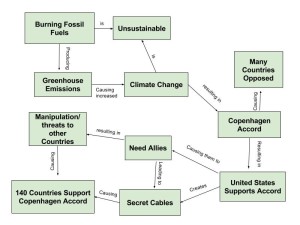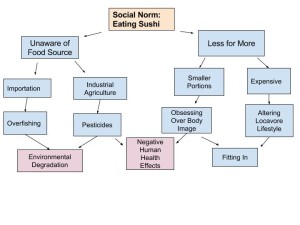1. Observe the biodiversity in a particular area in your hometown using the small scale technique. How do these individual organisms affect the biodiversity of the ecosystem as a whole?
Measuring the biodiversity of a particular area is impossible to do with the human eye. Rosevalley lake is located in my hometown of Montoursville, Pa. During the majority of the year the lake is swarming with a variety of different organisms. From a kayak I can observe different fish species, bird species, amphibians, and plant species. If I were to uproot a plant, or lift up a rock, I might find various worms, beetles, and invertebrates in the soil. Although you can not visibly observe the thousands of macro and micro organisms inhabiting the lake water, a microscope would give you entirely different perspective of all the life supporting this small ecosystem.The birds and other large mammals prey on the fish. The fish feed on various worms, microorganisms and other insects. The insects rely on plants for survival. The plants could not survive without the various organic macro and micro nutrients they retain from the soil and the different pollination practices occurring from insects. Each organism in this area is interconnected to one another and plays a key role in maintaining a healthy ecosystem.
2. List a specific threat to biodiversity in the area you chose for question 1. How could this threat be prevented?
Pollution is a big threat to the biodiversity of Rosevalley lake. Hydraulic fracking has become very prominent in Northeastern Pa and within the past five years there has been an increase in development. There are now over five gas wells surrounding the lake, Fracking is not only a very unsustainable form of development, it is also very hazardous to our environment. As mentioned in module 10, a discharge of toxic synthetic chemicals and heavy metals into the environment has a major impact on biodiversity. Not only does fracking have the potential to contaminate ground waters, the toxic substances are evaporated into the atmosphere creating contaminated air and acid rain. If these toxic substances were to leak into the lake there is also a big risk of bioaccumulation in animal tissues. Rosevalley is very popular game lake in my area. Not only does it feed the surrounding carnivorous populations, many people rely on these fish to help feed their families. If the lake were to become contaminated, humans would be at a direct risk of impacts from bioaccumulation of toxins as well as different mammals and avian species. Many mammals also use this lake as a source for drinking water. Contaminated water could not only affect the local community but it could negatively affect migratory species as well. The chemicals could have a potential to create a dead zone that is completely uninhabitable for fish and other wildlife. The only way to prevent the lake from becoming contaminated is to eliminate hydraulic fracking entirely. Fossil fuels used for energy are becoming progressively scarce and there are more sustainable, environmentally friendly methods to this downside of development.
3.Choose a current event in which invasive species have negatively affected biodiversity. What does Biodiversity mean to you? How can it be sustained?
Invasive species introduced to nonnative habits are causing declinations in native species. For example in New Caledonia, fire ants or (Wasmaiinia auropunctata) were accidentally introduced to the island through travel. Although these ants are tiny in size, they are having a substantial effect on the ecosystem. Fire ants create supercolonies that can cover miles of land area. These tiny ants have a lack of natural enemies, therefore causing a demographic surge. Fire ants prey on crustaceans, insects, seeds, floral nectar, snails, and worms. They’re able to inject a powerful venom, driving potential competitors from existing resources. Studies have shown these powerful ants have made a decrease in the density and diversity of native arthropods since they were first introduced to the island. Reptiles, birds and other species rely on arthropods for food. The loss of native arthropods is causing the reptiles numbers to decline which is also causing other species numbers to fall. Furthermore, these insects are known to indirectly spread a variety of plant diseases, which negatively affect the health of the ecosystem. Additionally, invasive fire ants are causing implications on agricultural activities, economy, and the welfare in the community of New Caledonia. The preservation of biodiversity is crucial to the sustainability of life. Each organism has it’s own specific contribution to maintaining a healthy ecosystem. This vast network of genetic, and ecological biodiversity is what makes life livable on earth. Habitat degradation, pollution, invasive species, destruction and climate change are some of the many man made factors negatively impacting biodiversity. Ecocentric ethical views are critical to the preservation of healthy ecosystems. Being environmentally aware and conserving land for its own benefit could ultimately preserve all life as a whole. Biodiversity is the root to all life. Without biodiversity, life simply would not exist.
http://www.bbc.com/news/uk-14432401
http://journals.plos.org/plosone/article?id=10.1371/journal.pone.0067245



